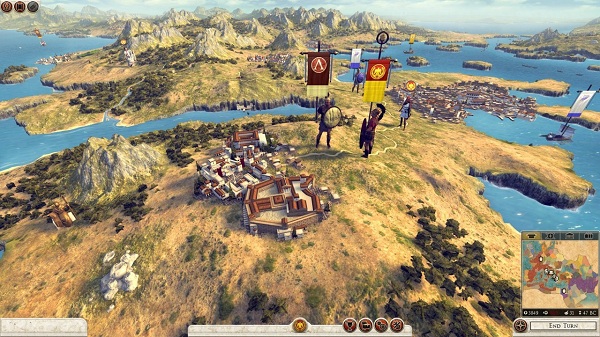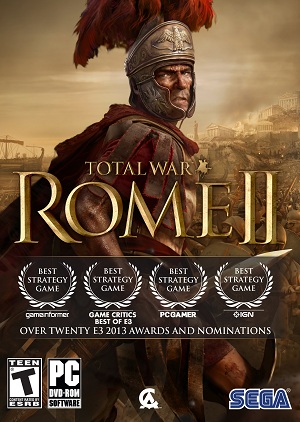 BUY IT FROM AMAZON: RIGHT HERE!
BUY IT FROM AMAZON: RIGHT HERE!
BUY IT FROM STEAM: RIGHT HERE!
PLATFORM: PC
PRICE:$59.95
ESRB RATING: T
DEVELOPER: Creative Assembly
PUBLISHER: Sega
Creative Assembly’s Total War series has in recent years become more about extrapolation than diversity, with them returning to their earliest works and upping the scope and complexity. The most pervasive result has been a slightly awkward new naming scheme. Like Medieval 2 and Shogun 2, I find myself keep thinking of the original title order and calling this game Rome: Total War 2 then having to correct myself; I’m thinking of just settling on calling it 2 Rome 2 Total to make things easier on myself.
More than any of their previous revivals, Rome 2 is a big deal for CA: the original was arguably their coming-out moment as a major strategy developer, the point where Total War became the mainstream titan it is today, and arguably still their finest game (Though Shogun 2 may just have been refined now to the point where it pips it at the post for this honour). This isn’t just about surpassing the first game: with Rome 2, CA needed to move the goalposts all over again.
Do they? Not really, but they do enough to make the experience worthwhile by not reinventing the chariot wheel, but putting extra effort into the carving. You still control a faction out to expand by grabbing land off other nations, achieved through diplomacy, careful management of cities and waging spectacular, real-time battles, and again, evolution comes in the options available to you as to how to go about this.
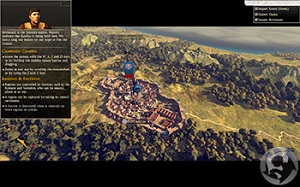 Key to CA’s modernization of Rome is the concept of accessibility, starting with the Prologue mini-campaign, which has traditionally served as the tutorial to each new Total War game. This time CA do not just rely on an anonymous advisor character to guide the new player along, but instead get them to fill the shoes of upcoming general Gaius Fulvius Silanus, voiced by CHUD favourite Mark Strong. It’s an interesting twist that makes it much more engaging than your average tutorial, but structural issues let it down. Rather than taking its time and instilling in the player the routines necessary to effective play, it seems content with a quick whip through some (but not all) of the new mechanics and feeling more like a tease than a true tutorial.
Key to CA’s modernization of Rome is the concept of accessibility, starting with the Prologue mini-campaign, which has traditionally served as the tutorial to each new Total War game. This time CA do not just rely on an anonymous advisor character to guide the new player along, but instead get them to fill the shoes of upcoming general Gaius Fulvius Silanus, voiced by CHUD favourite Mark Strong. It’s an interesting twist that makes it much more engaging than your average tutorial, but structural issues let it down. Rather than taking its time and instilling in the player the routines necessary to effective play, it seems content with a quick whip through some (but not all) of the new mechanics and feeling more like a tease than a true tutorial.
Interestingly, it’s also a shame to have to say goodbye to Mark Strong’s Silanus. Strong was born with the perfect pipes for a character like this (See also: THQ’s underrated Space Marine) and injects enough charisma into Silanus to make you wonder how a full campaign just playing him would pan out. While nobody would change the emergent narrative Total War provides, a Silanus DLC campaign would be an interesting way to give a directed perspective on CA’s vision of Ancient Rome.
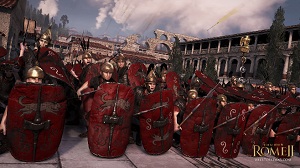 Jumping into a campaign proper (As the Iceni, to see how the game handles ‘The Other Guys’) yields few genuine surprises, a lot of nice touches and a few things that still need a bit of spit and polish. The new households system introduces a personal touch to the franchise that seems directly influenced by Paradox’s Crusader Kings II. You pull your generals from the ranks of the ruling families, which in turn increases your influence and lowers the possibility of rebellion. You can also marry successful generals off in the hopes of producing talented offspring, helping to inject some personality into your regime. It certainly encourages you to take care of your more accomplished generals, but don’t go thinking you’re going to encounter the kind of household insanity that defines CKII: It’s a nice touch, and offers the chance for your top generals’ traits to live on past death, but it ultimately adds an interesting wrinkle to proceedings rather than shaking anything up too dramatically.
Jumping into a campaign proper (As the Iceni, to see how the game handles ‘The Other Guys’) yields few genuine surprises, a lot of nice touches and a few things that still need a bit of spit and polish. The new households system introduces a personal touch to the franchise that seems directly influenced by Paradox’s Crusader Kings II. You pull your generals from the ranks of the ruling families, which in turn increases your influence and lowers the possibility of rebellion. You can also marry successful generals off in the hopes of producing talented offspring, helping to inject some personality into your regime. It certainly encourages you to take care of your more accomplished generals, but don’t go thinking you’re going to encounter the kind of household insanity that defines CKII: It’s a nice touch, and offers the chance for your top generals’ traits to live on past death, but it ultimately adds an interesting wrinkle to proceedings rather than shaking anything up too dramatically.
Elsewhere, micromanagement has been generally pared down in ways that mostly work. Territory is now divided into provinces made up of individual regions, each with their own settlement. You can specialize each region based on of the types of buildings you construct in them; you may have one province specialize in military production, for example, while another is set up for economic growth. This encourages a more considered approach to settlements, weighing up the size of your empire and the needs of your population when considering whether to specialize or diversify production in a settlement (Short version: specialization seems to be more useful for large empires, while diversity is better for small ones). It also requires a more methodical approach to claiming territory, each region lost weakening the province as a whole. It also makes managing public order a more sweeping thing instead of being forced to tinker here and there. It doesn’t stop public order being the traditional speedbump-dispersing pain in the arse it’s always been, but it at least makes the busywork a tiny bit less convoluted and feels a bit more involving than the stat-crunching grind happiness generally turns into in the grand strategy genre.
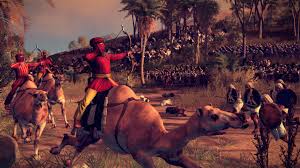 The simplification of army and fleet management is a trickier question. Merging and unmerging is simpler than ever, and armies will automatically convert to fleets and back again whenever you need to move them by sea (At least, most of the time – more on that below). Experienced armies can also be issued ‘traditions’ – perks similar to those you award the generals with – and can be placed into different stances based on their needs, such as marching hard to grant a travel bonus per round, or building fortifications if you need them to defend a particular spot. The campaign map appears to have been largely designed with these stances in mind, with large open spaces for quick-marching and lots of narrow chokepoints ideal for fortifications and ambushes. The downside to this, however, is that it reduces the map to clearings and corridors, limiting range of movement and making things like positioning of reinforcements for battle far fiddlier than it needs to be. Also, be prepared for a bit of a wait at the end of each round as the game calculates all the other factions’ moves (Word to the wise: Make sure that one of the first things you do when going into the game is to go into the settings and uncheck ‘Show CPU Moves’. It helps).
The simplification of army and fleet management is a trickier question. Merging and unmerging is simpler than ever, and armies will automatically convert to fleets and back again whenever you need to move them by sea (At least, most of the time – more on that below). Experienced armies can also be issued ‘traditions’ – perks similar to those you award the generals with – and can be placed into different stances based on their needs, such as marching hard to grant a travel bonus per round, or building fortifications if you need them to defend a particular spot. The campaign map appears to have been largely designed with these stances in mind, with large open spaces for quick-marching and lots of narrow chokepoints ideal for fortifications and ambushes. The downside to this, however, is that it reduces the map to clearings and corridors, limiting range of movement and making things like positioning of reinforcements for battle far fiddlier than it needs to be. Also, be prepared for a bit of a wait at the end of each round as the game calculates all the other factions’ moves (Word to the wise: Make sure that one of the first things you do when going into the game is to go into the settings and uncheck ‘Show CPU Moves’. It helps).
And that brings us to the other half of the experience: The totally warring stuff. One of the first things that stands out is how the recruitment process has been reworked, with armies able to go into a state of mustering. While you raise armies at settlements by appointing a general, when out in the field they can replenish themselves wherever they are rather than have to schlep to the nearest city. This is handiest when preparing to go into battle, but requires care as armies can only recruit a handful of units each turn, and cannot move while mustering. You’re probably looking at three or four turns to raise a respectable army, with at least five or six before you have a good one, so you’re going to want to make sure that there’s no risk of enemy interference.
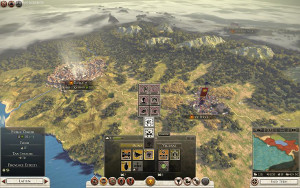 And of course, once you have your army there’s the business of breaking head, Roman style. The battles are pretty much in the same ilk as recent Total War games, for good and bad. AI on both sides still isn’t the brightest, with enemies rather improvisation-shy and your own units still prone to grinding to a halt mid-battle and needing extra pushes along. On the upside, chasing your routing foe through the streets of their city is still an utter thrill, and while coordinating units mid-battle is still an indelicate and treacherous process, the scope and cinematic flair CA bring to the battles always makes them enjoyable. Naval combat is handled more like land battles this time round, which makes them a bit more user-friendly, but still feel a bit clunky and ill-explained, and are still autoresolve fodder.
And of course, once you have your army there’s the business of breaking head, Roman style. The battles are pretty much in the same ilk as recent Total War games, for good and bad. AI on both sides still isn’t the brightest, with enemies rather improvisation-shy and your own units still prone to grinding to a halt mid-battle and needing extra pushes along. On the upside, chasing your routing foe through the streets of their city is still an utter thrill, and while coordinating units mid-battle is still an indelicate and treacherous process, the scope and cinematic flair CA bring to the battles always makes them enjoyable. Naval combat is handled more like land battles this time round, which makes them a bit more user-friendly, but still feel a bit clunky and ill-explained, and are still autoresolve fodder.
Armies accrue XP and are upgradeable as always, and this time can earn Traditions for success in battle. These work like the traits awarded to generals, and grant basic stat buffs that are permanently tied to that legi. First up, this allows you to develop an army in specific directions – as great melee fighters, for example, or siege specialists. Secondly, even if the army is destroyed you have the option to pass its banner to a newly-raised one and bestow its legacy onto it, with tradition intact. This system is one of Rome 2’s highlights, and is great fun to tinker with though it does highlight that odd sense of division at the game’s core: while the battles are fun, the campaign side of the game is its richest, which makes managing the armies slightly more satisfying than actually using them. However, it’s difficult to not start getting attached to your star general and his crack legion which brings a welcome extra layer of personal investment to the series.
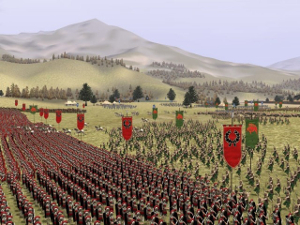 By and large, the best description of Rome 2 is that it is through and through a Total War game. There may be tweaks and the scope of the game may be bigger than last time, but as a game experience it’s exactly what you’re used to, and already know if you like or not. Unfortunately, it also conforms to the classic Total War experience in that it’s shipped in a familiarly bug-happy state. I personally haven’t experienced most of the big ones getting shrieked over on the internet at the moment, though I have come across issues with fleet management and disembarking armies. At a certain point in the tutorial I needed to drop Silanus and his legion off at a port, which should’ve been a simple case of ‘Unstack Silanus from his support fleet, disembark Silanus at port, leave support fleet in the water to guard port’. It sounds simple enough, but unfortunately the act of unstacking Silanus from the second fleet overlaid the fleets on top of each other, preventing both fleets from moving. After several turns scouring the tooltips and (Not always working) encyclopaedia, I eventually had to bite the bullet and disband the support fleet altogether. Gamebreaking? No. Annoying as hell? Absolutely, and the kind of thing that can seriously derail a campaign in late-game.
By and large, the best description of Rome 2 is that it is through and through a Total War game. There may be tweaks and the scope of the game may be bigger than last time, but as a game experience it’s exactly what you’re used to, and already know if you like or not. Unfortunately, it also conforms to the classic Total War experience in that it’s shipped in a familiarly bug-happy state. I personally haven’t experienced most of the big ones getting shrieked over on the internet at the moment, though I have come across issues with fleet management and disembarking armies. At a certain point in the tutorial I needed to drop Silanus and his legion off at a port, which should’ve been a simple case of ‘Unstack Silanus from his support fleet, disembark Silanus at port, leave support fleet in the water to guard port’. It sounds simple enough, but unfortunately the act of unstacking Silanus from the second fleet overlaid the fleets on top of each other, preventing both fleets from moving. After several turns scouring the tooltips and (Not always working) encyclopaedia, I eventually had to bite the bullet and disband the support fleet altogether. Gamebreaking? No. Annoying as hell? Absolutely, and the kind of thing that can seriously derail a campaign in late-game.
Apart from that, I experienced the far more universally-consistent issue with the game’s frame rate, which at the moment seems to chug at inappropriately low levels even with the graphics settings turned right down. Odd, given CA’s repeated assurances pre-release that the game would scale well to the vast majority of rigs. This seems to be affecting everyone no matter how tricked-out their setups, and another thing that doesn’t ruin the game but makes it that bit more frustrating to play.
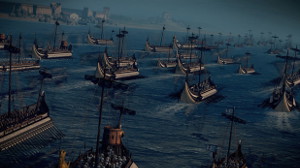 Like Empire: Total War and Shogun 2 will probably take a good year’s patching (And key fan contributions such as the ever-reliable DarthMod) before it reaches its full potential. In a year’s time you could probably add an extra star to this review, but for now it’s another game that feels like it should deserve more, but is unable to fully pull itself together to deserve it. It’s just as fun to play as its predecessors; even despite the nitpicks, CA know how to nail that cinematic epicness that makes every playthrough a great time, and one hopes that they keep exploring in the direction of personalizing the factions, families and generals even more, but its surface doesn’t bear much scratching before you start to see what it still can be.
Like Empire: Total War and Shogun 2 will probably take a good year’s patching (And key fan contributions such as the ever-reliable DarthMod) before it reaches its full potential. In a year’s time you could probably add an extra star to this review, but for now it’s another game that feels like it should deserve more, but is unable to fully pull itself together to deserve it. It’s just as fun to play as its predecessors; even despite the nitpicks, CA know how to nail that cinematic epicness that makes every playthrough a great time, and one hopes that they keep exploring in the direction of personalizing the factions, families and generals even more, but its surface doesn’t bear much scratching before you start to see what it still can be.
Have I enjoyed Total War: Rome 2? Absolutely? Would I recommend it? That would probably depend on the person involved. If you’re a passionate Total War fan, or if you don’t mind putting up with some bugs and design quirks at least until the big patches roll in, you’ll have a good time with Rome 2. Everyone else may be advised to wait a bit, or for an interim fix pick up the original Rome or Shogun 2, both classics that have gone through the birthing pangs and come out as immeasurably better games for it. I’d put money on this game following a similar trajectory, but unfortunately I can only review the game as it exists now and not what may be in a year’s time. For now, this is another case of the heart awarding a half star more than the head can justify… Yet.
Rating: 




Out of a Possible 5 Stars
